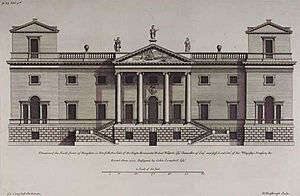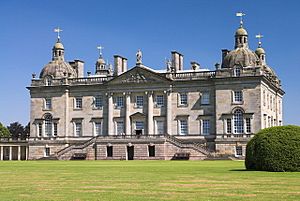Houghton Hall facts for kids

Houghton Hall is a large country house in Norfolk, England. It is the home of the 7th Marquess of Cholmondeley.
Sir Robert Walpole, who was like the first Prime Minister of Britain, ordered the house to be built in 1722. It's a very important example of a style called Neo-Palladian architecture in England. The house is a special historic building, known as a Grade I listed building, and it's surrounded by about 1,000 acres (4 square kilometers) of parkland. It's also close to Sandringham House.
Contents
What Houghton Hall Looks Like
The main part of the house is shaped like a rectangle. It has a sturdy ground floor, with a grand main floor (called a piano nobile), a floor for bedrooms, and attics above. There are also two smaller sections on the sides, connected to the main house by rows of columns. To the south, there's a separate building for stables.
The outside of the house looks grand but simple, made from beautiful, light-colored stone. Domes designed by James Gibbs are at each corner. Inside, the rooms are much more colorful and fancy than the outside, which was a common style for Palladian buildings.
The park around Houghton Hall was redesigned in the 1700s by Charles Bridgeman. During this work, the old village of Houghton was moved and rebuilt near the park's main gates. The old medieval church, St Martin's Church, was left alone and now stands by itself in the park.
History of Houghton Hall
How the House Was Designed and Built
Houghton Hall was built on the same spot where earlier houses of the Walpole family stood. Sir Robert Walpole inherited the property and its large estate in 1700. He wanted to make some improvements, and in 1720, he asked Thomas Badeslade to survey the house and its gardens.
The exact story of how the house was designed is a bit debated. It seems Sir Robert Walpole first asked his friend Thomas Ripley to lead the design. Ripley was appointed as the surveyor in 1722 when construction began. The first stone was laid on May 24, 1722. By December of that year, the brick cellars were finished.
Colen Campbell is often given credit for the design. However, later studies suggest his main work on the design started in 1723. Campbell was involved, but his early designs showed different towers than the ones built. The final design for the tower domes was done by James Gibbs. The house was very expensive, costing over £200,000. The best materials and designers were used, including William Kent, who designed the ceilings and some furniture.
Who Owned Houghton Hall
Sir Robert Walpole loved to host big parties. Hunting trips with local friends would last for weeks. Kings and queens often visited, and his fellow politicians, especially those in his government, held their meetings at Houghton every spring. These meetings were called the Norfolk Congress. Houghton Hall was meant to be the permanent home for over 400 of his famous paintings, including works by artists like Van Dyck and Rembrandt.
Sir Robert Walpole became the 1st Earl of Orford in 1742. After him, his son and grandson owned the house. When the third earl died in 1791, ownership went to Sir Robert Walpole's youngest son, Horace Walpole, who became the 4th Earl of Orford. Sir Robert and the other Earls of Orford are buried in St Martin's Church nearby.
When Horace Walpole died in 1797, the house went to the family of his sister, Lady Mary. She had married George Cholmondeley, 3rd Earl of Cholmondeley. Since then, Houghton Hall has been cared for by her descendants, the Cholmondeley family, right up to today. A funny story is that an overdue library book, borrowed by Colonel Robert Walpole in 1667 or 1668, was found at Houghton in the 1950s and returned 288 years late!
Houghton Hall Today
The house, including its attached parts, was officially recognized as a Grade I listed building in 1953.
Houghton Hall has stayed mostly the same over the years. It wasn't changed much, even when many other old houses were being updated in the 1800s. This is because the family mostly lived at Cholmondeley Castle in Cheshire during that time. Houghton Hall still belongs to the current Marquess of Cholmondeley. Parts of the house and its grounds are open to the public at certain times of the year.
Art at Houghton Hall
Houghton Hall once held a huge collection of paintings belonging to Sir Robert Walpole. His grandson, the 3rd Earl, sold many of these paintings in 1779 to Catherine the Great of Russia. This was done to help pay off some of the family's debts. Today, the collection still includes some important paintings, like Thomas Gainsborough's painting of his own family.
Sir Robert Walpole also had a large collection of marble Roman busts (sculptures of heads and shoulders).
In the early 1990s, a famous painting by Hans Holbein the Younger called Lady with a Squirrel and a Starling was taken from Houghton Hall. It had been there since 1780. The painting was sold to help pay taxes and for the upkeep of the house and grounds. It was eventually sold to the National Gallery for £17 million because it was considered a national treasure.
Today, with art prices being very high, old families with big collections sometimes face tough choices. In recent years, some artworks from the Cholmondeley family have been given to the Victoria and Albert Museum instead of paying taxes. A big sale of items from Houghton, including pictures, furniture, and silver, happened in 1994 to create a fund for the house's future care. Some art, like William Hogarth's portrait of the Cholmondeley family, is still at Houghton and can be seen by visitors. However, the Marquess knows that there's always a risk of theft. For example, Jean-Baptiste Oudry's White Duck was stolen from the collection in 1990 and is still missing.
Parkland and Gardens
The design of the parkland at Houghton by Charles Bridgeman is still mostly the same today. His "twisting wilderness paths" were cleared in the early 1700s and have been kept up since then. The park, which reaches into other villages, was also recognized as a special historic park in 1987.
Bridgeman changed the park from straight paths to blocks of woodland and open parkland. He felt this new design better matched the grand house. Tree-lined views in four directions point towards the Hall.
The "ha-ha" barriers at Houghton were a new idea from Bridgeman. A ha-ha is a sunken fence that lets you see the landscape without a visible barrier. Horace Walpole explained in 1780 that it allowed the park and garden to blend together with the wilder countryside outside.
Sir Robert Walpole built a water tower (1731–32) that looked like a decorative building, or "folly." It was designed by Henry Herbert, 9th Earl of Pembroke. It was fixed up in 1982 and is also a Grade I listed building.
In recent years, the current Marquess of Cholmondeley has added several modern outdoor sculptures. To the west of the house, there's a circle of stone designed by British sculptor Richard Long.
Two modern follies are in a wooded area near the west side of the house.
American artist James Turrell created a special building called Skyspace for Houghton. From the outside, it looks like an oak building on stilts. Inside, you look up through an open roof, which makes you focus on the sky.
"The Sybil Hedge" is another interesting feature nearby. It's based on the signature of the current marquess's grandmother, Sybil Sassoon. Scottish artist Anya Gallaccio made a marble structure that looks like a sarcophagus (a stone coffin). Nearby, there's a hedge of copper-beech trees planted in lines that copy Sybil's signature.
A 5-acre (20,000 square meter) walled kitchen garden is located beyond the stables. Over time, this garden became smaller and mostly covered in grass. In 1996, it was redesigned and replanted. In 2007, it won an award for being the Historic Houses Association and Christie's Garden of the Year. Yew hedges divide the space into different "rooms," each with a unique feel. These rooms include an Italian garden with patterned box hedges, a formal rose garden, a French garden with trained lime and plum trees, and a croquet lawn.
Danish artist Jeppe Hein created a Water Flame sculpture for this garden. This fountain has a jet of water topped by a ball of flame, showing a modern "folly" on a smaller scale.
In 2015, James Turrell also created a special light display for Houghton House as part of a festival.
Horse Trials
The Houghton International Horse Trials have been held in the park every May since 2007. These events include national and international horse riding competitions.
Model Soldiers
The stable building at Houghton Hall is home to the Cholmondeley Collection of Model Soldiers. This collection was started in 1928 by the 6th Marquess and has grown to include about 20,000 figures. It was moved to Houghton Hall in 1980 when the house opened to the public.
See also
 In Spanish: Houghton Hall para niños
In Spanish: Houghton Hall para niños
- Treasure Houses of Britain
- Noble Households
External links
- Official website: http://www.houghtonhall.com
- Houghton Hall entry from The DiCamillo Companion to British & Irish Country Houses
- Houghton International Horse Trials






